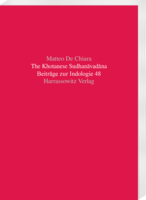|
weitere Titel zum Thema:
Download:
Bitte beachten Sie: Mit digitalen Produkten in Ihrem Warenkorb
wird die Bezahlung nur per PayPal möglich. Der Download dieser Produkte wird bereitgestellt, wenn die Bezahlung bestätigt ist. The Sudhanavadana is an agreeable tale which relates a story of a previous life of the Buddha: that of prince Sudhana and his wife, the fairy princess Manohara. Core of the work is the journey of Sudhana in search of his lost consort. Written in a Middle Iranian Language, i.e. Khotanese, spoken in Central Asia and used to compile Buddhist works, this tenth-century Late Khotanese poem is preserved in three virtually complete manuscripts and seven fragments all found in Dunhuang. The manuscripts and fragments must go ultimately back to a single source, but what remains are two distinct recensions: indeed, it may be assumed that, in order to conform to the needs of different audiences, the story was modified in the course of time to obtain two recensions that still run in parallel but are independent from each other, either one being complete in itself.
After the introduction, Matteo De Chiara’s study of the Khotanese Sudhanavadana provides a diplomatic edition, a critical edition, where the two Khotanese versions have been put in parallel and are followed by the corresponding passages in the Sanskrit parallel works, i.e. Ksemendra’s Bodhisattva-avadana-kalpalata and the Divyavadana, and a final glossary, indicating all loanwords and confrontations from Indian languages. Transcribed and translated, with critical apparatus, the text has been divided into logical paragraphs which render the understanding of the matter easier. Furthermore an additional volume will offer a philological commentary containing a complete discussion and explanation of problematic passages and words, as well as parallels from other Khotanese and Sanskrit texts. |
|||||||||||||||||||||||||||||||||||||||||






